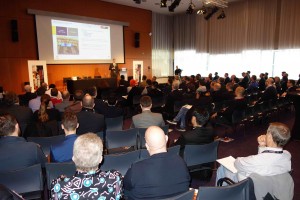Sports Venue Technology Summit: Best practice in digital signage for arenas
 Digital customer journeys are now dominating planning in sports arenas – from wayfinding to menu boards, and from perimeter boards to video cubes. For the opening session of Sports Venue Technology Summit at the ISE show in Amsterdam, SVG Europe invited Florian Rotberg, founder of Invidis Consulting, to discuss the opportunities presented by digital signage in sports arenas and stadia, and provide an insight into the digital signage concepts of tomorrow.
Digital customer journeys are now dominating planning in sports arenas – from wayfinding to menu boards, and from perimeter boards to video cubes. For the opening session of Sports Venue Technology Summit at the ISE show in Amsterdam, SVG Europe invited Florian Rotberg, founder of Invidis Consulting, to discuss the opportunities presented by digital signage in sports arenas and stadia, and provide an insight into the digital signage concepts of tomorrow.
“I am probably an anomaly here today, as we don’t do a lot in sporting arenas. But we do a lot in digital signage, so I would like to give you some of my insights and share some ideas and give you some recommendations on how you can use best practice learned in retail for sports arenas.
“We’re based in Munich and are ten people strong. We know what doesn’t work, and we know the few things that work. The key thing is to provide one seamless user experience. That is especially difficult in the digital world as you have so many different agencies – you have all kinds of screens and they’re not really coordinated. And that’s the biggest challenge we have in retail, arenas, airports; we need to have one user experience. The customer doesn’t care who operates the hospitality or restaurant or shop,” said Rotberg.
“The biggest advantage of digital signage is that these are fixed displays. In mobile we all need to invest in connectivity and engagement, no question, but digital signage is a one to many media. This is very important, not only for crowd control in emergency situations but the platform is fully managed by the owner of the system. That’s the biggest advantage over mobile.
“Digital signage revolves around three main pillars: you need a good concept, you need content and you need hardware. Hardware is the easiest one; there’s lots of good hardware out there nowadays. Investing in content costs lots and lots of money, especially in stadiums, as they are not as busy as airports for example, where you have 24/7 usage,” he said.
“In the past digital signage was fixed; it was put on the wall and that was it. Nowadays more than half the displays are somehow integrated with the furniture. They are not something that is added at the end; they are an essential part of the whole retail design, the whole experience, the customer journey. That means we need to consider digital signage concepts from the beginning; this makes it more difficult at the outset, but more rewarding afterwards.
“In terms of technologies as you know we have LEDs, LCD standard displays, OLED is coming up and QLED is also emerging from Samsung. We believe OLED and QLED are not competitive right now. It looks very nice, but has not proven itself and we believe it will take another two to three years before it is as good as the manufacturers currently pretend.
“Resolution is increasing. Is 4K or 8K really necessary from the digital signage standpoint? Definitely No: the higher resolution the higher the cost, and especially getting an ROI in sporting arenas is a major challenge so we believe you should focus on full HD for digital signage. Full HD is fully OK for the next few years; don’t go for 4K. You are free to do it, but it just hikes up cost – and no real benefit for the consumer,” said Rotberg.
“One thing that’s really important is digital asset management. This is becoming more and more popular. In the past, content concepts were done separately for retail or hospitality, but nowadays we’re looking at a central database where all the images and information is centrally stored and managed – and with one button press you can send information to every display, regardless of format or orientation. We believe digital asset management is now really important, not only for digital signage but to use the same information for your web site and your mobile apps. You enter the data only once and then distribute.
“Live transit information is one key trend in digital signage,” he said. “One good example is Fenway Park in Boston, where they use a board to show live traffic information. The smart thing is to not just focus on one supplier, ie public transport in Boston, but they also show how many Uber cars are available and how many rental bikes are available and so on. You have all these options as to how to get back and forward to the stadium. They use this on a big promotion board, where they display advertisements during games, and then they switch to transit information which is very helpful. Dynamic transit information is something we believe will become more and more important – and the audience will expect it.
“Many operators don’t see digital signage as an essential thing to have. When you talk about digital signage in sports arenas, try to forget about the current sponsor and think about is as an essential part of your architecture and operation. Make sure that you have a sustainable concept for your digital signage.
“We know that concept and content are really relevant, and sometimes putting in fewer displays and investing more in content is important – plus having ownership and having a maintenance concept to operate it for many years. This is really essential,” said Rotberg.


